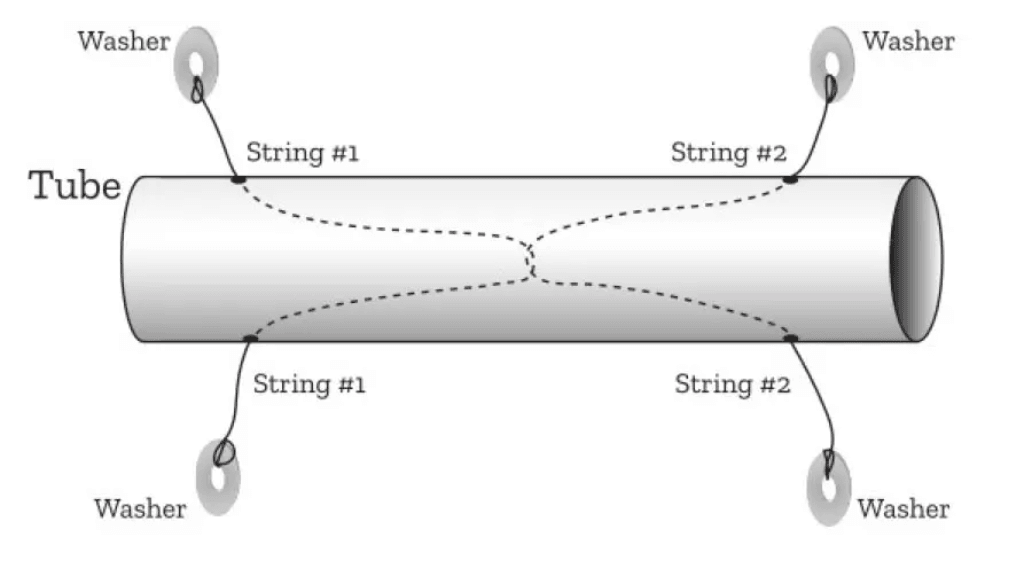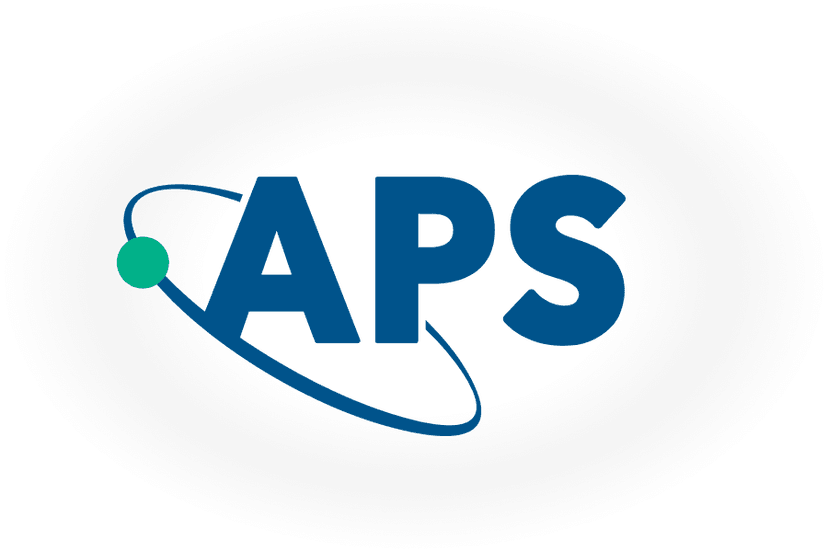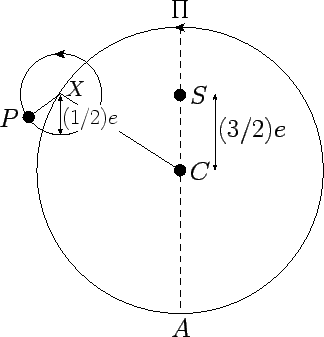This is the teacher guide for this lesson. A student-focused guide to assist learners as they perform the activity is available.
Mystery Tube
What is a scientific model and how do we create one?
This resource was originally published in PhysicsQuest 2021: Introduction to the World of Quantum.
What is a scientific model and how do we create one?
- One drinking straw: cut up to tie to the ends of the string for the mystery tube to use as washer
- One tube: 1.5 in. x 9 in. x 0.04 in.
- One push pin: to pierce the side of the tube before the skewer is used to create the hole
- One skewer: 4.5 in. x 11/64 in. to create the appropriate size hole in the tube
- One thin pull wire to make threading the string through the holes easier
- Yoyo string
- Paper/whiteboard + pen/marker to write your observations
Have you ever wondered how scientists figure out how things work when they do not have a direct way of measuring the phenomena? For example, how do we know that the structure of an atom consists of electrons revolving around a positively charged nucleus, like the planets around the sun? In this activity, we will learn how to build scientific models based on observations, realize that different models can explain the same observations, and refine our models based on new data.
- Total time45 - 60 minutes
- Education levelGrades 5 - 9
- Content AreaQuantum mechanics
- Educational topicModels and modeling
The job of a scientist is to build models. Models are a way to create a mental picture of how something works. They are representations of real-life events, objects, or systems.
Models can be used to gain an understanding of phenomena or processes which are difficult to observe directly. If an event occurs too slow or fast of a speed to detect directly or on a difficult scale to measure, creating a model to understand how it works makes things a lot easier. Sometimes the observable is impossible to see directly, or doing so would be too dangerous. Therefore, we use models to try to replicate those systems or events.
In order to remain as accurate as possible, one must constantly refine and adjust a model when new information or data is received. For example, scientists initially believed that the Earth was the center of the solar system, with the Sun and all other objects rotating around. Astronomy knows this as the geocentric model. Scientists believed this because what they could observe was that the Sun appeared once a day everywhere around the Earth.
The stars also rotated every day in a similar form. They also observed that standing on Earth, Earth did not seem to move, which then led them to believe that the Earth was stationary. Therefore, their geocentric model well predicted what they could observe at the time.
However, in 1543 Nicolaus Copernicus presented a new model in which the Earth rotated around the Sun. Copernicus used the fact that observations of other planets in the solar system seen from Earth would require very complicated trajectories. Using his knowledge of mathematics and orbits, he proposed a new model to predict the same day, night, moon, planet, and star observations but with simpler trajectories.
Quantum mechanics is a field of physics that is very hard to study, especially before advancing technology, as it studies things that are on a very, very small scale, like the atom and smaller. Physicists have used models to study the phenomena of quantum physics. Another challenge of quantum physics is that, because we do not live or experience life at that tiny scale, it is not directly intuitive to predict what will happen in a quantum system.
Often our observations of quantum phenomena challenge what we observe on the bigger scales. Therefore, it is challenging to create models that replicate the quantum observations and make sense in the non-quantum scale. In many quantum phenomena, there are no direct comparisons to the classical world. In the classical world, we measure things and observe behaviors to create models.
However, in the quantum world, every attempt to observe what is happening alters the data, limiting the ability to refine models. One of the first examples of scientists using models to understand quantum mechanics in our classical world was with the atom model. Another example critical to the quantum mechanics field is the conundrum of an electron and how it can behave like both a wave and a particle. We will learn more about particle-wave duality in our next activity.
These are the key terms that students should know by the END of the two lessons. They do not need to be front loaded. In fact, studies show that presenting key terms to students before the lesson may not be as effective as having students observe and witness the phenomenon the key terms illustrate beforehand and learn the formalized words afterwards. For this reason, we recommend allowing students to grapple with the experiments without knowing these words and then exposing them to the formalized definitions afterwards in the context of what they learned.
However, if these words are helpful for students on an IEP, ELL students, or anyone else that may need more support, please use at your discretion.
- Scientific model: A physical, conceptual, or mathematical representation which can be used to explain and predict the behavior of real objects or systems seen in natural phenomenona that are difficult to observe directly.
- Phenomenon: An observable fact or event of scientific interest.
- Approximation: A mathematical quantity that is close in value to but not the same as a desired quantity; being close or near.
- System: A group of interacting items forming a unified whole.
- Peer review: A process by which something proposed (as for research or publication) is evaluated by a group of experts in the appropriate field.
- Quantum mechanics: A fundamental theory in physics that provides a description of the physical properties of nature at the scale of atoms and subatomic particles.
Students will assess, analyze, and predict what is happening inside the mystery tube to understand how models are created, reviewed, and modified based on new data and consensus.
- Turn & talk protocol
Give students examples of pictures, diagrams, 3D models to look at. Ask them to describe the purpose of a model in science.
- Pair students up.
- Give them a minute to think quietly.
- Give students 2 minutes to discuss their thinking.
- Have students record their answers or share out to the whole group.
Don’t let students view you making the tubes. Maybe have another classmate help you create them so participant students don’t know what is going on inside. To construct your mystery tube:
Make two holes an inch and a half from the end of each side of the tube. Ensure the holes are directly across from one another. You can use a pen to push through the cardboard tube to make the holes.
Repeat for the two bottom holes, so you have four holes in total.
Cut the string into two.
Thread one length of string through one of the top holes and then out through the hole below. Tie the washers that we made from each end of the string.
Repeat the same for the other two holes with the other piece of string. Thread the string through the other string, as seen in the figure.

Cover the ends of the tube. You can also have different variations of the mystery tube to prompt discussion, for example, one with a ring instead of threatening the strings, or doing top/lower holes instead of left/right holes.
Encourage students to build their own mystery tube without revealing how you built the original tube. Here's an alternative way to build your tube.
Provide a mystery tube per group (groups of 5 max). Tell students that they need to draw a design of how the tube works without opening the tube. Ask students to follow the scientific method, to formulate hypotheses/predictions of what will happen when they pull the different string ends. Does it make a sound when you shake it? Does the diameter of the tube, strings, rings matter, or the length?
Allow students enough time to try their combinations, noting the motion and tension of the strings or anything else that might help them decipher how the tube looks inside.
Once the students in the group have reached a conclusion, ask them to draw their designs and share them with the class. Provide some time for a peer-review process in which students get to ask questions about their peers’ designs. Ask the groups if they want to revise their model after the peer-review session is completed.
Once students have revised their models and adjusted their designs, provide the materials they request and ask them to build their own model.
With the class, define a way to systematically test the accuracy of each group’s model – maybe by analyzing the diagram to see if it could predict the behavior that is actually witnessed when the strings are pulled, how the physical model compares to the diagram, and if it actually behaves as it was expected.
- Suggested STEP UP Everyday Actions to incorporate into activity:
- When pairing students, try to have male/female partners and invite female students to share their ideas first.
- As you put students into groups, consider having female or minority students take the leadership role.
- Take note of female participation. If they seem to be taking direction and following along, elevate their voice by asking them a question about their experiment.
- Consider using white boards so students have time to work through their ideas and brainstorms before saying them out loud.
- As students experiment, roam around the room to listen in on discussion and notice experiment techniques. If needed, stop the class and call over to a certain group that has hit on an important concept.
Consider using the RIP protocol (Research, Instruct, Plan) for lab group visits and conferring.
Consider culturally responsive tools and strategies and/or open ended reflection questions to help push student thinking, evidence tracking, and connections to their lives.
Once all the models are built, use the accuracy test to judge the models. The models must be judged primarily on their ability to explain and predict the observations.
Discuss how different models can arrive at the same observations and reflect what areas of science use models in similar ways – such as the model of the atom or the electron (particle and wave).
Do not reveal the inside of the original tube.
- Real world connections:
- Have students read stories about scientists and their discoveries and make comparisons to the approaches that they used in "solving" the mystery tube.
- Suggestions for drawing, illustrating, presenting content in creative ways:
- Blog about using the mystery tube in the class.
- Engineering and design challenges connected to the content:
- Have groups partner up to redesign the mystery tube. Have them switch to see if the other group can “solve” their mystery tube.
Credits
Coordination, research, text, and editorial review: Jessica Eskew, Jamie Liu, Leah Poffenberger, Catherine Tabor, Laurie Tangren, and Rose Villatoro
Graphic design and production: Meghan White
Cover illustration: Annamaria Ward
Activity 3, "Save Schrodinger’s Cat,” was created by the team behind Quarks Interactive SRL. Concept: Laurentiu Nita
Design and art: Ar. Judit Balazs-Becsi
Writing: Dr. Nicholas Chancellor, Dr. Helen Cramman, Dr. Laura Mazolli Smith, and Andrei Voicu Tomut
Activity 4, "Quantum Circuits," was created by our partners at Virginia Tech: Sophia Economou and Edwin Barnes. Supported by the National Science Foundation (grant nos. 1741656 and 1847078)
PhysicsQuest is sponsored in part by the Eucalyptus Foundation.
Updated in 2023 by Sierra Crandell, MEd, partially funded by Eucalyptus Foundation
Extension by Jenna Tempkin with Society of Physics Students (SPS)


